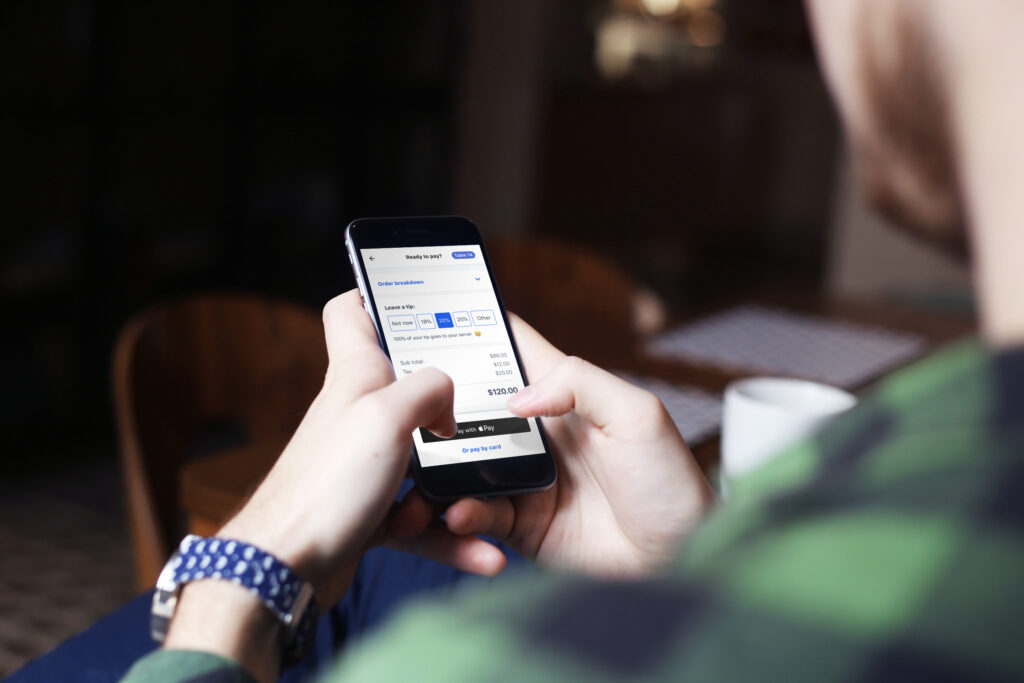Thanks to continuous innovation in technologies such as mobile web applications, digital payments, NFC, chip and pin and so on, operators have several options when it comes to digital ordering and payment at the table. Here’s a quick overview of what these options are and their pros and cons.
Ordering
Tablets
Restaurant-owned tablets that are either handed to guests by the server when seated or are fixed to the table. Tablets are best suited to fast casual dining set-ups and higher end concepts especially where speed is key e.g. airports and train stations.

Pros
- Large form factor for engaging menu imagery and easy menu navigation
- Doesn’t require guests to check-in to their table
Cons
- Hygiene – customers might be less willing to touch a share device, especially since the pandemic
- Cost of hardware
- Cost of maintenance
- Cost of updating both hardware and software
- Guests may be less willing to enter personal information on a shared device, making it less suitable for payments and loyalty programs
Mobile
Guests use their own mobile device to order and pay within a restaurant. It’s a good channel for restaurants without table service and guests who want to order more but don’t want to leave their seat; restaurants in airports or train station locations to meet guests’ needs for speed and efficiency. It also suits restaurants with table service, especially an open check mobile journey that allows customers to keep adding to their order then pay at the end.

Pros
- No hardware, set-up or maintenance costs
- No hygiene issues
- Suitable for payments and loyalty
- Open and closed check options
- No reliance on server or tablet availability
Cons
- Mobile ordering can be done through the mobile’s web browser, however, if a brand does opt for a native app, it would come with some development and upkeep costs.
Payment
Tableside payment
Wait staff bring a card reader to the table for guests to either pay with a card, contactless card or mobile payment.

Pros
- Reduce cash handling costs
Cons
- Cost of hardware
- Cost of maintenance
- Cost of updating them
- Hygiene
- Guests need to wait until either staff or a card reader is free to pay
- It may be awkward for guests to input tip amount in view of the server
Mobile
Guests use their own device to retrieve their check and pay. It’s best suited to table service where speed and table turn rate is key.

Pros
- No hardware, set-up or maintenance costs
- No hygiene issues
- No need to wait for available staff or payment terminal, guests can retrieve their check and pay when it suits them
- Guests can easily split their check with others at their table
- Option to leave tip in private
Cons
- If opting for a native app vs. web app, there would be a development and upkeep cost associated with it. It’s worth noting, mobile ordering and payment can be done through a mobile web page and doesn’t require an app download. Brands tend to opt for native apps because it fits in with a specific brand or operational need, but it isn’t a requirement for mobile ordering.
Hospitality operators now have a range of options when it comes to at table ordering and payment but mobile offers many unique benefits that other channels don’t. From speeding up operations and turning tables faster to better hygiene and greater control by customers over their experience, the adoption of at table mobile technology has exploded in the last 12 months. Brands looking for a ways to reduce pressure on staff so they can focus on higher value activities such as bringing out orders or explaining the menu to customers have also turned to mobile to address these challenges and we only see this trend continuing.
If you’re interested in at table mobile ordering and payment, get in touch or check-out what QikServe has to offer here.





